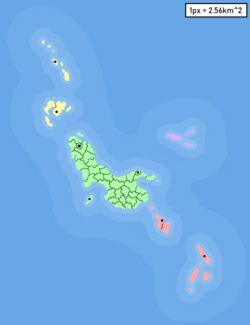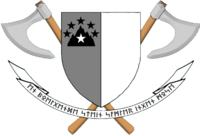Flatstone
De Republikken Flatstein The Republic of Flatstone | |
|---|---|
| Motto: "En bølgende stein samler ingen mose." | |
| Anthem: The Rock Cycle Song | |
 | |
| Capital and largest city | Shale |
| Official languages | Norwegian English |
| Ethnic groups | Stoenian |
| Demonym(s) | Stoenian Steinmann (Norwegian) |
| Government | Full Presidential Republic |
| President Leif Erockson | |
| Dwain Jonsin | |
| Legislature | The Congress of Flatstone |
| Formed | |
• established by rogue pillagers | September 21st 1791 |
| Area | |
• Total | 22,662 km2 (8,750 sq mi) |
| Population | |
• 2019 estimate | 5,600,000 |
• 2010 census | 5,443,412.4 |
• Density | 247.1/km2 (640.0/sq mi) |
| GDP (PPP) | 2018 estimate |
• Total | $0.45 Trillion |
• Per capita | $51,461.95 |
| GDP (nominal) | 2018 estimate |
• Total | $455.3 Billion |
• Per capita | $51,461.95 |
| Gini (2018) | 24.9 low |
| HDI (2018) | very high |
| Currency | Silver Stone (SVST) |
| Time zone | UTC-2 (FST) |
• Summer (DST) | UTC-2 (not observed) |
| Driving side | left |
| Calling code | +224 |
| Internet TLD | .rock |
Government
1791-1810 The Flatstone Civil War
The history of Flatstone began on the 21st of September, 1791. When one of the two nomadic pillager groups settled onto an island in the middle of the Marmor Sea. This group called themselves the "Livløs" and spoke only Norwegian. They had a small force of around 400 men, although once 2,000 strong, countless failed attempts at pillaging had resulted in their dwindling numbers. These men had decided that enough was enough and now that they had become a known threat, they had no other place to run but the inhabited island located in the middle of the Marmor Sea. Three years had passed by the time any civilization was established, and by 1794, an estimate of five small towns/settlements were established across the northwest part of the island. By late 1794, another one of the two nomadic pillager groups had received word about the recently discovered uninhabited island, and they saw an opportunity. The next tribe to arrive on the island established their first settlement on the southeast part of the island and laid claim to some of the coastal islands further west. These would become known as the "Bergensere" and were infamous to foreign nations for being ruthless and unforgiving. Although they had an advantage over the Livløs, and that advantage was numbers. The Bergensere had not taken as many losses as the Livløs had in previous raids because of superior experience and equipment.
Both clans would go on to expand into the eastern territory, with the Bergensere expanding a small distance to the west and the Livløs expanding a small distance to the south. But before the entire southwest could be annexed by the two growing clans the Livløs split into two because of the monarchy that had been put into place, giving the leaders of the Livløs clan the majority of the supplies that their people desperately needed. The third clan that would emerge would call themselves the "Frigjørere", or Liberators. The Frigjørere and the Livløs would be involved in multiple border clashes over the course of thirteen years, even though they were fighting a war of attrition without enough supply to feed their men, let alone their people, these clashes would continuously happen throughout 1797-1799 and would result in the deaths of around 3,000 civilians and pillagers alike. These clashes are remembered as the "Breen Mountain Conflicts". By 1801, the Bergensere would have taken all of the western islands, and expanded halfway into the north, along with into one of the settlements that had been built by the Frigjørere. After three more years of constant stalemates, a fourth pillager clan arrived in the northeast after foreigners from the nation of Fallooplesburg that had sought religious refuge and safety from the civil war that was going on in 1804. Although because of the Bergenseres superior equipment, experience, and numbers, they had been invaded and annexed by the Bergensere by 1806, with many of their citizens massacred during the conflict. This would give the Bergensere a giant advantage over the other two nations that had already been starved of both men and supplies because of multiple conflicts internally and between each other. Preparations for war were made with the other two tribes throughout 1806 and 1807, as the Bergensere aimed to let the settlements that were massacred in 1805 recover, and by mid-1808, the invasions had begun into the south of the Frigjørere Clan, but with the large army of the Bergensere that had been met with almost no resistance, the Frigjørere was unable to react. They would end up collapsing under the intense pressure of the Bergensere.
The Livløs were dumbfounded at the sight of the Bergensere Clan being able to wipe out an enemy that the Livløs couldn't beat in 11 years, and they were in no way prepared to face the army of 6,000 men marching into their cities at alarming rates. Their men were squashed like bugs by August of 1809, and by 1810, the leaders of the Livløs Clan had already been publicly hanged. The Bergensere had successfully reunited the province of what would now be known as Flatstone under one rule, after 13 years of Civil War. This conflict would come to be known as the Flatstone Civil War.
1811-1840 Recovery and Colonization
By the time 1811 had rolled around, the Bergensere had only just began the recovery of their tarnished island. Most of the citizens that hadn't been massacred were welcomed with open arms once the civil war had ended, not including Fallooplesburg immigrants, who would go on to be oppressed until the beginning of the 18th century. The leaders of the Bergensere Clan knew that the whole concept of a pillager clan was out of the question, and one of their top priorities should be to establish a functional government. By 1812, all territories of the province Steinøy were now discovered and controlled by the Bergensere. Along with this, a monarchy had been established, with the highest leader of the Bergensere Clan claiming the throne for himself. During this time, around 95% of the population spoke Norwegian, and were considered ethnic Stoenians. Because of this, it wasn't hard for the King of Flatstone to give the people a reason to unite, and the people of the island put up almost no resistance. Instead, they began to rebuild their settlements that had been plundered during the war. Ports also began to be constructed along the coastline of the island, and small military fortifications for the former men of the Bergensere were constructed throughout the isles. By 1814, society had almost completely recovered from the war and had managed to move on and accept their annexation. In November 13th, the Bergensere Clan named the territory they currently owned the Steinøy province, and turned it's force of 3,000 men into a small army. This would mark the beginning of the Steinhær. On December 26th of 1814, the Monarchy announced that the clan of the Bergensere would now be known as the Kingdom of Flatstone, and created the Flatstone Royal Family, made up of direct descendents of the King. This group of Flatstone royalty had the most authority throughout the country, and were considered figures of high importance. On January 1st of 1815, the capital of Flatstone was declared to be the city of Shale, located on the western most tip of the island.
A whole year of peace and political silence passed, until the idea of exploration further expansion in the Marmor Sea was brought up in late 1816. The Monarchy saw this as an amazing oppurtunity, and began the construction of a navy right away. They managed to finish 52 ships of varied sizes by February 17th of 1817 and had already scheduled expiditions to set out to the north of the island. A small set of isles was discovered on May 21st, and the expiditionary force established a settlement on the southernmost island. Word got back to the Monarchy, and the Royal Family decided to annex the islands and claim them as territory of the Kingdom of Flatstone. These islands would later become known as the Kongeøyene province, or "The Kings Isles".

